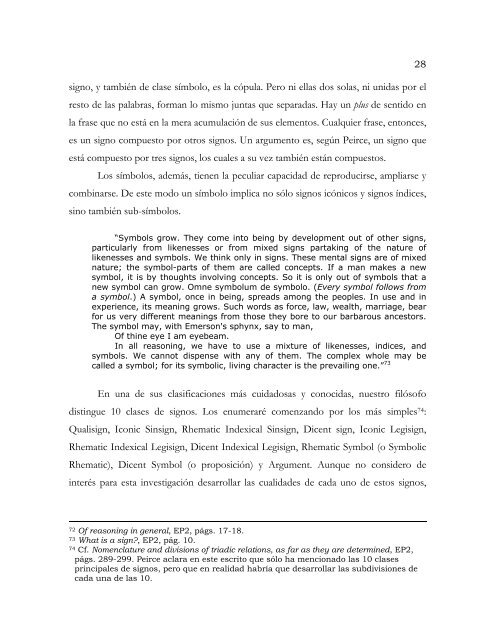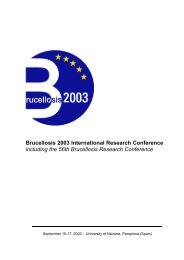Aportes filosóficos de Charles Sanders Peirce - Universidad de ...
Aportes filosóficos de Charles Sanders Peirce - Universidad de ...
Aportes filosóficos de Charles Sanders Peirce - Universidad de ...
You also want an ePaper? Increase the reach of your titles
YUMPU automatically turns print PDFs into web optimized ePapers that Google loves.
28<br />
signo, y también <strong>de</strong> clase símbolo, es la cópula. Pero ni ellas dos solas, ni unidas por el<br />
resto <strong>de</strong> las palabras, forman lo mismo juntas que separadas. Hay un plus <strong>de</strong> sentido en<br />
la frase que no está en la mera acumulación <strong>de</strong> sus elementos. Cualquier frase, entonces,<br />
es un signo compuesto por otros signos. Un argumento es, según <strong>Peirce</strong>, un signo que<br />
está compuesto por tres signos, los cuales a su vez también están compuestos.<br />
Los símbolos, a<strong>de</strong>más, tienen la peculiar capacidad <strong>de</strong> reproducirse, ampliarse y<br />
combinarse. De este modo un símbolo implica no sólo signos icónicos y signos índices,<br />
sino también sub-símbolos.<br />
“Symbols grow. They come into being by <strong>de</strong>velopment out of other signs,<br />
particularly from likenesses or from mixed signs partaking of the nature of<br />
likenesses and symbols. We think only in signs. These mental signs are of mixed<br />
nature; the symbol-parts of them are called concepts. If a man makes a new<br />
symbol, it is by thoughts involving concepts. So it is only out of symbols that a<br />
new symbol can grow. Omne symbolum <strong>de</strong> symbolo. (Every symbol follows from<br />
a symbol.) A symbol, once in being, spreads among the peoples. In use and in<br />
experience, its meaning grows. Such words as force, law, wealth, marriage, bear<br />
for us very different meanings from those they bore to our barbarous ancestors.<br />
The symbol may, with Emerson's sphynx, say to man,<br />
Of thine eye I am eyebeam.<br />
In all reasoning, we have to use a mixture of likenesses, indices, and<br />
symbols. We cannot dispense with any of them. The complex whole may be<br />
called a symbol; for its symbolic, living character is the prevailing one.” 73<br />
En una <strong>de</strong> sus clasificaciones más cuidadosas y conocidas, nuestro filósofo<br />
distingue 10 clases <strong>de</strong> signos. Los enumeraré comenzando por los más simples 74 :<br />
Qualisign, Iconic Sinsign, Rhematic In<strong>de</strong>xical Sinsign, Dicent sign, Iconic Legisign,<br />
Rhematic In<strong>de</strong>xical Legisign, Dicent In<strong>de</strong>xical Legisign, Rhematic Symbol (o Symbolic<br />
Rhematic), Dicent Symbol (o proposición) y Argument. Aunque no consi<strong>de</strong>ro <strong>de</strong><br />
interés para esta investigación <strong>de</strong>sarrollar las cualida<strong>de</strong>s <strong>de</strong> cada uno <strong>de</strong> estos signos,<br />
72 Of reasoning in general, EP2, págs. 17-18.<br />
73 What is a sign?, EP2, pág. 10.<br />
74 Cf. Nomenclature and divisions of triadic relations, as far as they are <strong>de</strong>termined, EP2,<br />
págs. 289-299. <strong>Peirce</strong> aclara en este escrito que sólo ha mencionado las 10 clases<br />
principales <strong>de</strong> signos, pero que en realidad habría que <strong>de</strong>sarrollar las subdivisiones <strong>de</strong><br />
cada una <strong>de</strong> las 10.
















